Pile foundation strapping: device features and installation recommendations
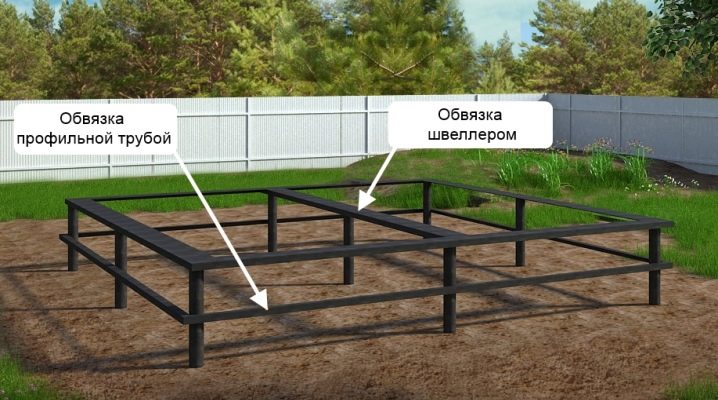
The strapping of the pile foundation is extremely important, as it significantly increases the strength and stability of the house structure. It can be carried out in different ways and has its own nuances in each case.
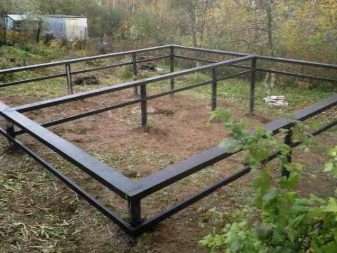
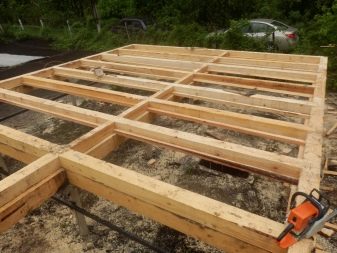
Why is strapping necessary?
A pile foundation is always preferable when it comes to timber and frame structures. In addition, it is relevant for non-standard soil characteristics, in different climatic zones up to the Far North.
Its advantages are:
- use in difficult weather conditions and on difficult soils;
- the ability to use with different types of relief;
- long service life (up to 100 years);
- quick and easy installation;
- affordable cost, unlike other types of foundation.
The advantage of this design is also considered the absence of excavation work, since the piles are screwed into the ground at a strictly calculated freezing depth at certain intervals.
After this, the binding becomes a mandatory step. It is on it that the reliability and strength of the structure depends, and, consequently, the durability.

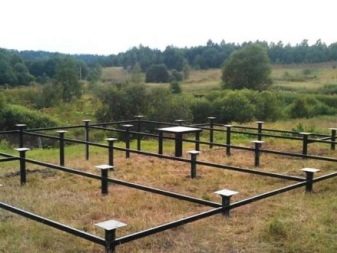
The upper part of the pile foundation is necessary to strengthen the structure, therefore, the grillage, as a rule, is built.
Its main functions are:
- is a support for the walls and ceiling of the basement;
- serves to evenly distribute the load between the piles;
- prevents overturning of the supports and their displacement by increasing the spatial rigidity of the base.
For strapping, grillages made of timber, channel bars, reinforced concrete, wooden boards and other materials can be used. In this regard, the installation will have some differences. You can do it yourself if there is no special equipment for immersing the screw supports in the ground.
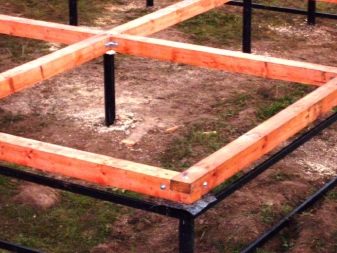

Strapping with a bar
A grillage from a bar is used when a frame or timber house is planned. In this case, the strapping can be done independently by a couple of people. Do not forget that you should pay attention to the strength of the selected wood. Better if it is oak, larch or cedar - these are the strongest and most resistant to external influences of the species.
The work is carried out in the following order:
- the timber is mounted on heads, which are treated with antiseptic impregnations before installation - the wooden parts must dry completely;
- after installing the piles, steel platforms with a thickness of 4 mm and a size of 20x20 cm are welded onto them, holes with a diameter of 8-10 mm are made to fix the timber;
- then the welds and heads are coated with nitro paint or anti-corrosion agents;
- bikrost or roofing material is laid on metal platforms;
- the first crown - a row of timber is laid on them, the ends are put paw in paw;
- using a measuring tape, the accuracy of the structure's geometry is checked, after which the timber is fixed to the piles with platforms with screws 150 mm long and 8-10 mm in diameter, in addition, bolting can be carried out by drilling through the bars.
Pile heights can be measured using a hydraulic level. Only after checking all the parameters, you can engage in further construction.
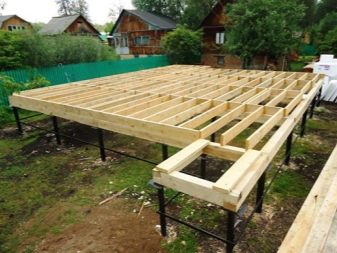
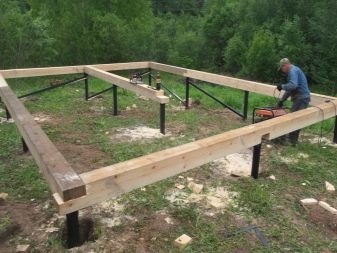
Prefabricated timber beam
For the pile-screw foundation, a board with a thickness of 50 mm is used.If the grillage height above the blind area is not more than 0.4 m, it is not necessary to strengthen the structure, but if a level of 0.7 m is observed, it is necessary to tie it with a profile pipe. If this size is exceeded, such a procedure is carried out at intervals of 60 cm.
Installation takes place as follows:
- sites are harvested on the supports;
- the first board is laid with the wide side down, fixed with bolts and washers;
- on the already fixed tree, 4 more boards are fixed upright, tightly to each other, fasteners are carried out with self-tapping screws, the hardware must be fastened from the bottom side;
- professionals recommend smearing each joint with an adhesive before fixing;
- after fixing to the bottom board, the structure is bolted through and through;
- another board is placed on top, securing it with nails and self-tapping screws.
Many are interested in what composition to protect the grillage from the boards. Best suited for these purposes is the wood preservative "Senezh" or "Pinotex Ultra", as for waterproofing compounds, it may well be liquid rubber or similar sealants.



Grillage from a metal channel
Tying with a channel is used in the construction of brick, frame, chopped and squared structures. Such a structure is especially stable and reliable. But a profile pipe or a standard I-profile with a section of 20 mm can also be used, which provides even greater rigidity of the structure, especially if a heavy building is expected.
To work with a channel, a U-shaped profile with a section of 30-40 mm is used. During such work, the heads are not installed on the piles, and the steel element is simply welded to the support.
The strapping technology includes the following steps:
- after the installation of the support piles, all pillars must be strictly aligned at the zero mark;
- after measuring the details of the grillage, the channel is marked and cut into pieces of the required length;
- all metal elements are treated with anti-corrosion compounds in two layers;
- profiles are mounted on poles and cut at the joints at right angles;
- the grillage is fixed by welding, after which the seams are covered with a primer mixture.
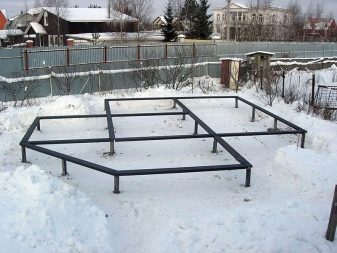
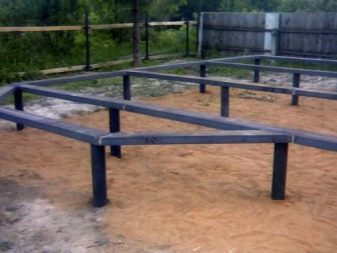
In some cases, a professional pipe can be used, which is fixed by a similar method. This material is lightweight and affordable. However, it should be borne in mind that this product is more susceptible to mechanical stress, therefore, the stability of the entire structure will be much lower.
A metal channel is chosen as an all-rolled one, since it can withstand higher loads than elements made by bending.
Finding out which strapping is better - of course, this is installation using an I-beam or channel grillage, but, on the other hand, a lot depends on the type of building.

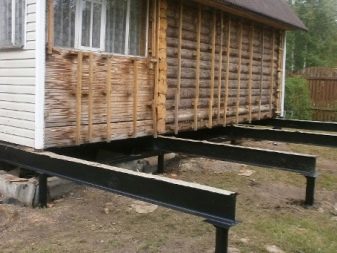
Corner mounting
Corner strapping is the most practical and economical solution, since these profiles are much cheaper than a channel or I-beam. For strapping, you will need parts with equal sides (75 mm each).
Algorithm of work:
- first, the screw piles are leveled by cutting, the cut points are ground;
- heads made of sheet steel are welded to them, plates from the sides are reinforced with kerchiefs;
- the level is used to check the height of the platforms;
- the central axis is marked;
- the corners are mounted with a shelf upward to the outer contour, in the corners the profiles are cut at an angle of 45 degrees;
- then the corners are welded to steel platforms with high-quality welds;
- the next step is to install the corners of the inner contour, they are also stacked with a shelf up and welded;
- lastly, they are engaged in the welding of partition profiles and cover the metal parts with two layers of paint, at the end they clean the seams.
It is impossible to use corners that were already in use, since a decrease in the safety factor of these products can negatively affect the strength of the structure being erected.
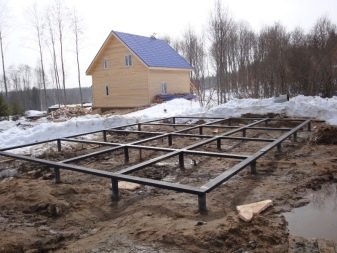
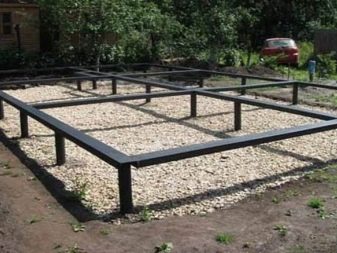
Use of reinforced concrete
The reinforced concrete grillage strapping has some disadvantages - labor-consuming installation and stoppage of construction work until the grillage is completely hardened, which occurs within 28-30 days. However, such an installation will cost much less than using metal profiles.
Installation involves the following steps:
- support piles are exposed at the same level;
- formwork is prepared from planks with internal glued upholstery to avoid leaks;
- a frame is erected from metal reinforcement, horizontal parts are fastened with wire vertically;
- the structure is lowered into the formwork, welded to the piles, and then poured with concrete mortar.


After pouring, it is advisable to compact the concrete with reinforcing rods or vibration.
You should be aware that ground grillages are used only with stable soil. If the soil is prone to heaving, then it is more advisable to use the hanging option. In the construction of multi-storey buildings, the strapping is usually done using recessed structures.
Correct strapping of the pile-screw foundation guarantees the strength and durability of the building. This is especially true if the building is being erected on unstable, weak soil or swampy terrain. Difficult terrain also requires paying due attention to this important workflow.
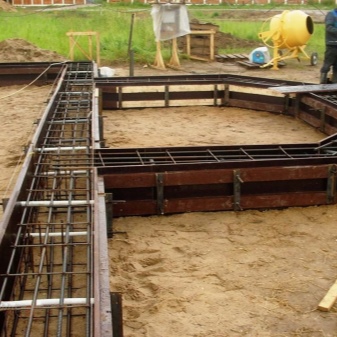

Tips for strapping the pile foundation are in the next video.













The comment was sent successfully.